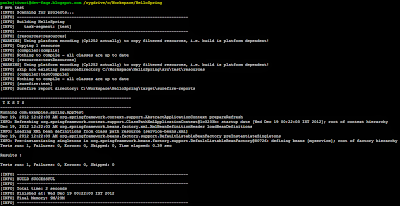The most elementary operation performed by the Spring Framework is setting the property value via Setter Injection. The AppTest class is a junit test class which validates the property set through setter injection.
package com.examples.spring;
import junit.framework.Assert;
import org.junit.After;
import org.junit.Before;
import org.junit.Test;
import org.springframework.context.ApplicationContext;
import org.springframework.context.support.ClassPathXmlApplicationContext;
/**
* File: AppTest.java
*
* Setting property via Setter Injection
*/
public class AppTest {
ApplicationContext ctx = null;
@Before
public void setup() {
ctx = new ClassPathXmlApplicationContext("service-beans.xml");
}
@After
public void cleanup() {
}
@Test
public void testPropertyInjection() {
Service srvc = (Service) ctx.getBean("myservice");
Assert.assertEquals(srvc.getServiceName(), "TimerService");
}
}
The
service-beans.xml is the beans configuration file where service name property is defined<?xml version="1.0" encoding="UTF-8"?>
<beans xmlns="http://www.springframework.org/schema/beans"
xmlns:xsi="http://www.w3.org/2001/XMLSchema-instance"
xsi:schemaLocation="http://www.springframework.org/schema/beans http://www.springframework.org/schema/beans/spring-beans.xsd">
<bean id="myservice" class="com.examples.spring.Service">
<property name="serviceName" value="TimerService"></property>
</bean>
</beans>
The
Service bean class which is instantiated by the Spring Frameworkpackage com.examples.spring;
/**
* File: Service.java
*/
public class Service {
private String serviceName;
public String getServiceName() {
return serviceName;
}
public void setServiceName(String serviceName) {
this.serviceName = serviceName;
}
}
Output



No comments :
Post a Comment